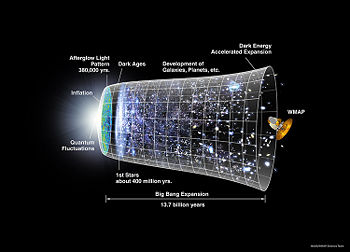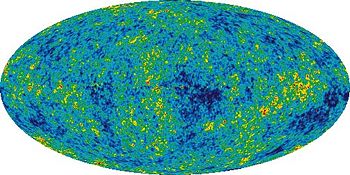Cosmic inflation
The Cosmic Inflation theory proposes that there was a period in the very early stages of the cosmos in which extremely rapid, exponential expansion of the universe took place prior to the more gradual Big Bang expansion. During the period of inflation, the energy density of the universe was dominated by a cosmological constant-type of vacuum energy. Later, the vacuum energy decayed to produce the matter and radiation we see in our universe at present. Inflation was rapid. It increased the size of the universe by a factor of ~1026 in only a small fraction of a second. When the period of inflation had ceased, essentially, the universe, which began as a quantum fluctuation about 1020 times smaller than a proton, had grown to a sphere about 10 centimeters in diameter in 15 X 1033 seconds. The inflation was rapid enough to overcome gravity and in fact had expanded faster than light. [1][2]
The inflation theory was developed by Alan Guth, Andrei Linde, Paul Steinhardt, and Andy Albrecht but the evidence for the expansion and the Big Bang theory predate their work. By 1913, Vesto Melvin Slipher had already established the movement of the galaxies through their spectral shift. Using Slipher's data, Edwin Hubble measured the spectral shift of galaxies and was able to determine that the vast majority of galaxies are receding from us. He also discovered that the further a galaxy is from ours, the faster it is receding. One explanation for this observation is that the space of the Universe is expanding. That is, over time two points grow further apart; the very fabric of the Universe is growing.[3] Template:TOC-right
The spectral shift of light traveling through space is often compared to the audible pitch shift that occurs when a train is approaching or receding from an observer. The additional relative speed of the train causes the compression waves of sound to bunch up (go higher) or spread out (go lower). However, the speed of light is constant. No matter what the relative speed of an object is, the light emitted from it travels at a constant rate. A different mechanism is responsible for the spectral shift of light - cosmic expansion.
While light travels at a constant speed, the very space it occupies expands causing the wave nature of light to lengthen, thus lowering its perceived frequency. The further the light travels, the more of this space lengthening it will experience, and the more frequency shift it will exhibit.
It is interesting to note that gravity holds space together. We do not see this expansion in areas of the universe that contain much matter. For example, the space between stars in our galaxy is not expanding, nor is the space between atoms in our bodies. However, the density of matter in the space between galaxies is so low that cosmic inflation can occur.
Support for the Inflation Theory
Inflation provides theoretical answers to three problems that appeared in the earlier versions of the Big Bang Theory—the Horizon problem, Flatness Problem and the Monopole Problem:.
The horizon problem is simply this; the universe looks the same on opposite sides of the sky. This is counterintuitive given that there has not been sufficient time since the Big Bang for light to travel across the universe and back again: the horizons could never have been in causal contact with each other. However, the microwave background temperature strongly indicates that these regions were in contact in the past. How, then, do opposite horizons look the same?
The second problem, the flatness problem, is that the of Universe’s spacetime geometry. The Wilkinson Microwave Anistropy Probe (WMAP) has provided data that implies that the universe is geometrically nearly flat. This would seem to be in contradiction with Big Bang cosmology, which indicates that the curvature of spacetime grows in time. If the universe is as flat as the WMAP data indicates, it would mean that there were very specific conditions in the past, the probability of those conditions existing is so small as to stretch credulity.
This geometric configuration also implies that the Universe is at the point between eternal expansion and eventual collapse.
The Monopole Problem is also in contradiction with Big Bang cosmology since it predicts that a there should be a great many heavy and stable magnetic monopoles, yet they have never been observed.
The inflation Theory provides a significant degree of understanding of the current expansion of the universe and the original problems posed by the Big Bang Theory and as such is it now understood to be an extension of the Big Bang Theory [1][2]
References
- ↑ 1.0 1.1 WMAP Inflation Theory NASA
- ↑ 2.0 2.1 Inflation for beginners John Gribben, School of Life Sciences, University of Sussex
- ↑ Vesto Melvin Slipher John Peacock, Royal Observatory Edinburgh

